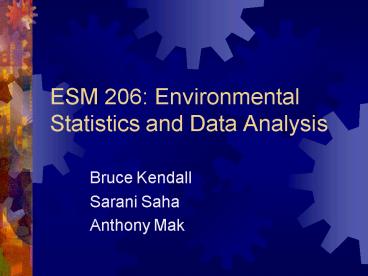ESM 206: Environmental Statistics and Data Analysis - PowerPoint PPT Presentation
1 / 9
Title:
ESM 206: Environmental Statistics and Data Analysis
Description:
Understand probability and how to formulate quantitative questions ... 4 during quarter (7-10 days each). Midterm (25%) Take home. Own work! Final or Paper (35 ... – PowerPoint PPT presentation
Number of Views:1051
Avg rating:3.0/5.0
Title: ESM 206: Environmental Statistics and Data Analysis
1
ESM 206 Environmental Statistics and Data
Analysis
- Bruce Kendall
- Sarani Saha
- Anthony Mak
2
Course Objectives
- Directed at MESM students in Bren School
- Understand probability and how to formulate
quantitative questions in context of randomness - Introduce commonly used statistical tools
conditions for use - Teach how to frame environmentally-motivated
question into testable hypothesis and how to use
tools to answer - Interpret results of analysis to provide insight
into environmental problems
3
The year is 1979. Concern is growing in Norway
about acidification of its lakes, and the
Norwegian government asks Britain and Germany to
reduce emissions of sulphur dioxide from their
power plants. In response, Britain demands proof
that their emissions are acidifying Norwegian
lakes. As science advisor to the Norwegian
government, you are asked to design a study to
produce this proof. What information should you
request be collected, and how should you analyze
it? 1.What specific questions need to be
answered? 2.What data address these
questions? 3.How can the data be used to provide
answers to these questions?
4
Resources
- Text Zar, 1999. Biostatistical Analysis, 4th ed.
Prentice Hall - Optional text Gonick Smith, 1993. The Cartoon
Guide to Statistics. HarperCollins. - S-Plus statistics package (installed in SCF GIS
lab)
5
Course Format
- Lectures
- 2 per week
- Expected to attend all lectures
- Lecture material applied and motivated with real
environmental problem - Labs
- 1 per week. T.A.s Sarani Saha Anthony Mak. In
GIS lab. - Bring questions dont expect to complete
homework in Lab sessions.
6
Grading
- Problem Sets (40)
- 4 during quarter (7-10 days each).
- Midterm (25)
- Take home. Own work!
- Final or Paper (35)
- If you choose a term paper
- 3 stages (proposal, progress, final paper)
- Can opt to take final to boost midterm grade
7
Topic Syllabus
- First Half of Course Basic Statistics
- What is statistics?
- Sampling, probability, distributions
- Regression, ANOVA
- Drawing Conclusions from data
- Second Half Special Topics
- Monitoring, Impact Assessment
- Time Series, Spatial Stats
- Survey design analysis
8
Expectations
- Of You
- Participate in class/lab
- Do readings
- Submit assignments on time (no late assignments
will be graded) - Do your own work
- Of Ourselves
- Keep it interesting
- Introduce techniques with real-world examples
- Make ourselves accessible
- Make lecture notes available
9
Information
- Name
- Program (MESM/PhD/dept)
- Area of interest
- Prior stats experience
- Favorite math experience































